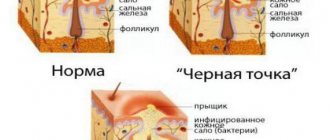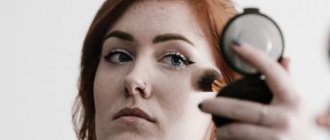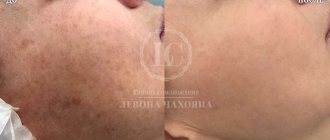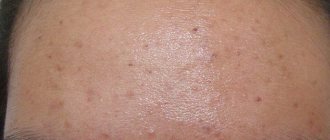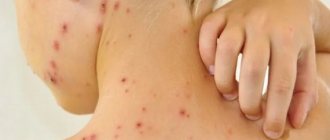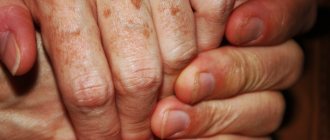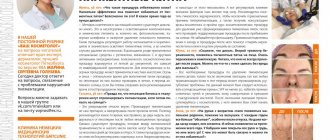Only 20 percent of schoolchildren can boast of healthy facial skin, the remaining 80 are forced to hide their hated acne behind long bangs and under a thick layer of foundation. How to get rid of acne? Let's talk to an expert.
Alim Khakuashev
Alim Khakuashev Dermatologist, cosmetologist, trichologist at the clinic for children and adolescents “SM-Doctor”
With the onset of adolescence, hormonal changes in the body begin. Testosterone is to blame for everything, the level of which affects the function of the sebaceous glands. During puberty, their function increases, resulting in acne. If a bacterial infection occurs, pustules will develop.
At 13-14 years old, black spots and red inflammation on the forehead and cheeks become the number one problem. The child looks at himself in the mirror with horror. No amount of persuasion and examples from stars (Cameron Diaz, Victoria Beckham, Rihanna) whose skin is far from ideal helps.
“Acne means endless ridicule from classmates,” says the mother of a 15-year-old son. — Clean facial skin helps you become more confident and overcome complexes. Unfortunately, there is no such miracle remedy that will get rid of acne once and for all. And dragging a teenager to a cosmetologist is also not easy. I really don’t know what to do.”
Mothers of girls on various forums also constantly discuss such topics. “How to cure these teenage acne? - asks Svetlana, mother of a 12-year-old daughter. — We already had ointments, tinctures, lotions, etc. in our arsenal. So far nothing has helped overcome this trouble. Grandmothers believe that in a couple of years everything will go away on its own, but I’m not sure.”
The cosmetologist warns that acne will not disappear on its own: “If you have facial skin imperfections, you need to contact a specialist as early as possible so as not to start the problem and take the necessary measures in a timely manner. Often, children and adolescents are embarrassed to see a doctor themselves or, due to their age, inadequately assess the severity of the disease. Therefore, parents should carefully monitor the condition of the child’s facial skin and, if necessary, immediately sound the alarm.”
What kinds of post-acne acne occur?
There are 3 types of post-acne, not only age spots:
- Scars are the most undesirable complication of post-acne
- Pigment spots – brown spots on the sites of former rashes
- Congestive erythema - redness accompanied by compaction from an unresolved element
All three types of post-acne can be present on the skin either simultaneously or separately, depending on individual characteristics and the tendency to develop pigmentation or scars.
Acne treatment with Clindovit® gel
Acne treatment is also possible at home. For mild to moderate acne, a dermatologist may prescribe Clindovit® gel, a topical antibiotic18.6. The drug contains clindamycin phosphate6. Upon contact with the skin, it hydrolyzes to form clindamycin, which exhibits antibacterial activity against P. acnes6. The Clindovit® gel base contains auxiliary components: allantoinemolent, which has a moisturizing and softening effect4,5.
Clindovit® gel is recommended to be used together with azelaic acid (for example, Azelik® gel) or benzoyl peroxide to reduce the risk of antibiotic resistance28.
*acne
The main predisposing factors for the appearance of post-acne
- Severity of acne – acne of III and IV severity often leads to complications, because affect the deep layers of the skin.
- Individual skin characteristics, genetic predisposition - such as dark skin color, a tendency to increase melanin production at the slightest inflammation or damage to the skin.
- Lack of treatment, inappropriate treatment, or late treatment is when the process has been present in the skin for a long time and has affected deep tissues.
- Skin injuries during mechanical cleaning, i.e. when roughly squeezing out pimples.
The presence of at least one predisposing factor may be the cause of the development of post-acne.
How is salicylic acid used in a cosmetologist's office?
Salicylic peeling has a keratolytic effect through protein denaturation. It has antiseptic and anti-inflammatory effects. The high level of lipophilicity ensures the penetration of the active substance into the deep layers of the skin, which explains the comedolytic effect of the procedure.
The cosmetologist uses 10% acid for superficial peeling, 15-20% for superficial-medium peeling and 30% for medium peeling. It is not worth experimenting with such concentrations at home157.
How to avoid age spots and scars
- Start acne treatment immediately. Even mild forms cannot be ignored - grade 0-2 acne, when there are single elements on the skin.
- Don't push! A banal but difficult point to implement. Skin cleansing can be done and sometimes even necessary, but it should be done carefully and competently by a cosmetologist.
- Use medications with anti-inflammatory effects. Not to be confused with antibacterial! Anti-inflammatory drugs have both preventive and therapeutic effects.
Recommendations follow from the previous paragraph - exclusion of predisposing factors.
Dangers of using salicylic alcohol for acne* on the face
You should avoid the decision to cauterize a pimple with salicylic alcohol, as using this product can have harmful consequences156:
- dry skin under the influence of the product begins to peel off even more, in response to overdrying of the epidermis, the production of sebum increases;
- salicylic acid is contraindicated during pregnancy and breastfeeding; if you have acne, consult a dermatologist; do not experiment with self-treatment at home;
- It is dangerous to mix the drug with other components to prepare homemade medicines; such cocktails can cause a negative reaction from the skin;
- Side effects of using the product include burning, itching, redness;
- When used according to the instructions, the drug is applied pointwise, since treating clean skin can lead to irritation and dryness.
An alternative to using an alcohol solution of salicylic acid may be medications for acne*, included in the Federal recommendations for the management of acne patients. These are azelaic acid, antibiotics, retinoids, benzoyl peroxide18.
How to get rid of post-acne
Recommendations of the International Society of Dermatologists and Cosmetologists: 1st line drugs for acne and post-acne treatment are retinoids .
- Have an anti-inflammatory effect;
- Normalize the functioning of pigment cells, lighten pigment spots;
- Normalizes the functioning of the sebaceous glands. With acne, the amount and composition of sebum changes - the main reason for the development of acne;
- Increase local immunity, which helps fight inflammation;
- Stimulate the synthesis of collagen necessary to fight scars.
Due to such a wide range of cosmetic effects on the skin, retinoids are recognized as the gold standard for the treatment of acne and post-acne.
The result of using retinoids:
- lightening pigment spots
- smoothing skin texture
- reduction of scar depth
Retinol benefits:
- Physiological – is a substance familiar to the skin, because the body itself supplies vitamin A to the skin in low concentrations;
- Has no toxic effect;
- Suppresses the increased activity of melanocytes, without destroying them, but normalizes melanin production;
- Penetrates well into the skin, reaching the necessary layers;
- Stimulates cellular renewal, preventing colored cells from remaining on the surface, and accelerates their exfoliation.
Salicylic alcohol for acne* on the face: application
The idea of using salicylic alcohol against acne is explained by its following properties 156:
- anti-inflammatory;
- antibacterial;
- antifungal;
- cleansing;
- drying;
- exfoliating.
Salicylic acid is used by cosmetologists for peelings. Uncontrolled use at home can also be harmful to the skin. But it is included in cosmetic products in small doses; their use can be useful in caring for problem skin.
Preparation with camphor
Camphor alcohol is less commonly used for acne on the face. It is no less effective for acne and increased secretion of the sebaceous glands. This is an excellent antiseptic that effectively treats acne. But do not forget that this drug can also cause negative reactions in the body:
- Frequent and copious use of camphor alcohol over large areas of the body can provoke severe allergic reactions.
- In case of overdose, symptoms such as dizziness, skin rashes, attacks of nausea, and tachycardia are observed.
- With prolonged treatment with this remedy, camphor will accumulate in the body and provoke convulsions.
Therefore, you need to remove acne very carefully using this method.
Camphor is applied exclusively pointwise, only to inflamed elements. To do this, soak a cotton swab in camphor alcohol and treat acne.
It is not recommended to use camphor to remove pimples on the chest, neck, and shoulders. In these areas the skin is too delicate and you can get burned.
Alcohol in cosmetics: pros and cons
We are accustomed to thinking of alcohol exclusively as denatured alcohol, but in reality alcohols are a huge family of substances with different properties, united only by the ending or hydroxyl group - OH. They perform many functions: from activating certain components to disinfection.
Groups of alcohols for use in cosmetics
There are three main types of alcohols: simple, aromatic and fatty. “The simple ones are used as an antiseptic. This is methanol / methanol, ethanol (that is, ethyl alcohol) / ethanol, isopropyl alcohol / isopropyl alcohol, denatured alcohol / alcohol Denat. They are used to impart homogeneity to products, to reduce pores and facilitate the penetration of ingredients, and also as preservatives. Aromatic alcohols have the same functions as simple alcohols, but are flavorful and act as preservatives. These are benzyl alcohol, cinnamyl alcohol, says Taisiya Petrova, cosmetologist and esthetician at the Aging Control aesthetic medicine clinic. - Fatty alcohols look different in appearance (they have a thick, waxy texture) and are gentler on the skin and do not dry it out. This is behenyl alcohol, caprylic alcohol, cetearyl alcohol, cetyl alcohol, decyl alcohol, lauryl alcohol, myristyl alcohol, stearyl alcohol, isuostearyl. alcohol / isostearyl alcohol, oleyl alcohol / oleyl alcohol.”
Effect of alcohols on skin
“The most consistent with the usual idea of “very bad and drying” are simple alcohols. They are dangerous because they can dry out the skin, accelerating the evaporation of moisture, and also disrupt the barrier functions of the epidermis. For sensitive skin, alcohol-containing products are undesirable, but the presence of alcohol is quite justified if the product is packaged in a pump bottle or spray. Without the ethanol solvent, the pump will clog after a couple of uses, and the alcohol that passes through it evaporates without a trace and simply does not reach the skin, explains Elena Eliseeva, a dermatologist and medical expert of the Vichy brand. — Aromatic alcohols are low-hazard because they are very volatile and evaporate even before the product is absorbed into the skin. Fatty alcohols include glycerin and panthenol. You definitely can’t blame them for their drying effect.”
“Fatty alcohols have excellent occlusive properties, significantly reducing the evaporation of water from the surface of the skin, which promotes hydration. This property is also widely used in nourishing creams. For dry and sensitive skin, these alcohols serve as softening and soothing aids. In multi-component cosmetics, fatty alcohols act as an emulsifier - they mix water and oil and act as a good thickener,” says Elena Saratseva, a dermatologist-cosmetologist at the Westmed clinic.
“The main property of simple alcohols is their antiseptic action. People like to add them to cosmetics to achieve a mattifying effect and tighten pores, but they have a short-term effect and dry out the skin,” says Victoria Kokoreva, cosmetologist at the BeatyCorner beauty salon.
Caution when handling alcohol-containing products
It makes sense to refuse only cosmetics containing simple alcohols like ethyl, and then only if the skin is very dry, sensitive and fragile. Aromatic alcohols can also be dangerous if taken in large doses. “Ethyl alcohol dissolves the hydrolipid mantle, depriving the tissue of protection. Initially, the skin looks less oily, but after a few hours the sebaceous glands begin to produce sebum with triple force, trying to compensate for its lack. In addition, it makes the skin thicker, causing increased tissue keratinization,” warns Elena Eliseeva.
“I do not recommend wiping your face with pure alcohol or alcohol tonics - it destroys the protective barrier and water-lipid mantle of the skin, as a result of which dermatitis and allergic reactions are possible,” recommends Taisiya Petrova.
“To be as safe as possible, choose products with minimal alcohol content. You can determine its share in the composition of the product by looking at the label. If alcohol is at the beginning of the list of ingredients, then its content is high,” advises Irina Kulakova, cosmetologist, dermatovenerologist, trichologist at the network of clinics of German medical technologies GMTClinic.
“Alcohol is safe for the skin, it is important to keep track of which alcohols are included in the composition and what problem you need to solve. People with sensitive skin should be especially careful,” adds Victoria Kokoreva.
Are there alcohol-free cosmetics?
There cannot be cosmetics without alcohols; they perform several functions - an emulsifier, a solvent, and a thickener. “Cosmetics without alcohol are essentially a mixture of oils, which will also periodically separate. Without ethyl alcohol, products for problem skin and men's skin will lose their refreshing and cooling effect; without cetyl or steraryl alcohol, the cream will lose its pleasant texture and will not nourish and soften the skin. Without panthenol, the most popular ointment will no longer heal abrasions. Cosmetics without alcohol are just as possible as cosmetics without active ingredients at all,” explains a medical expert from the Vichy brand.
“No harmful alcohols. Harmfulness or danger may occur with prolonged use of a cosmetic product in the form of irritation or dryness in sensitive skin. If your skin is hyperreactive, then it is preferable to use creams, lotions and toners without alcohol. The manufacturer always indicates the absence of alcohol on the packaging,” adds Elena Saratseva.
Harm
To answer the question: “Is it possible to wipe your face with alcohol?”, you need to evaluate not only its beneficial properties, but also its harm.
The biggest disadvantage of using ethanol is the destruction of the protective layer of the skin. It becomes susceptible to temperature changes, ultraviolet radiation and other natural influences.
The advantage of alcohol is that it dries the skin and relieves inflammation, but in addition to dead cells, healthy ones also suffer. This happens because they are located nearby. As a result of this exposure to alcohol, the skin becomes too dry. After this, you will have to moisturize your face, which is also harmful, because it can lead to excessive oiliness, which is favorable for the occurrence of acne.
Cosmetics that contain alcohol are most often intended for oily skin in order to dry it out. Only the sebaceous glands suffer from this effect. If you overdry oily skin, the opposite effect will occur. That is, the sebaceous glands will begin to work in an enhanced mode, and the face will again have an oily sheen. In addition, blackheads or increased rash may appear. And the abuse of alcohol-containing creams leads to the death of skin cells.
It is unacceptable to use ethanol on dry skin. Because this leads to loss of moisture and peeling.
Camphor alcohol
Is it possible to wipe your face with camphor alcohol? This drug is considered one of the most effective remedies in the fight against acne. But camphor alcohol should be used in combination with other drugs, because it eliminates the external manifestation of acne, but not the cause of its formation. The appearance of acne may indicate the presence of a disease that requires treatment.
Camphor alcohol cannot be used if you have an individual intolerance or allergies, so a test is also performed before use. You should wait about half an hour for a response from the skin.
Alcohol has many side effects - it irritates the skin, dries it out, and leads to burns. Therefore, the use of the product requires caution. It is not recommended to use the drug for people who have particularly sensitive skin.
Methods of disposal
Advising on what works well to remove acne marks on the face, experts draw attention to the need for an integrated approach:
- diagnosis by a doctor, drawing up recommendations taking into account the individual characteristics of the patient’s skin;
- consultation with a cosmetologist who will recommend hardware and injection methods;
- regular use of home care products.
What can you do at home?
To get rid of stains, it is best to take the advice of experts who recommend home care products designed to resolve scars, such as Contractubex. The enzymes contained in these medications are designed to break down the dense collagen fibers that form scar tissue.
But home peels and self-exfoliation are unlikely to give the expected effect. They act at the level of the epidermis, and acne is a deep-seated change in the skin that affects the dermis. That is why it is recommended to consult a doctor for professional treatment of post-acne and prescribe the necessary products, which should be designed for deep care.
What treatment methods are used in cosmetology?
How to quickly remove acne, spots, scars and cysts? Patients often come to a cosmetologist with such a request. Experts most often recommend the following treatment options:
- Phototherapy. Exposing the affected areas to light of a certain length improves the condition of the skin. As a result, inflammation decreases and erythema disappears.
- Microdermabrasion. This is a delicate procedure, during which the cosmetologist removes the top layer of the epidermis and carefully polishes its surface. It is effective if home cosmetics do not allow you to choose a product that can remove post-acne.
- Laser resurfacing. It is not mechanical and is necessary to improve the relief due to the action of the light beam. The laser allows you to fine-tune the depth of exposure, but it is important to remember that for about 10 days after it, crusts and redness will remain on the face.
The benefits of alcohol for skin
This method of getting rid of acne is very popular. Therefore, it is worth understanding the beneficial properties of alcohol. Then you can get an answer to the question: “Is it possible to wipe your face with alcohol?”
It is worth noting the frequent use of this substance in cosmetology and medicine. When used wisely, it becomes truly healing: it kills harmful microorganisms, reduces inflammation, promotes cleansing, dries out pimples, leading to their disappearance. Alcohol is also able to fight dead cells on the skin, softening it. Another interesting property is considered to increase the shelf life of cosmetics.
Due to its volatility, alcohol is widely used in various masks and creams. In this case, it is not absorbed, but evaporates before penetrating the skin. But here it is important to observe the proportions and concentration of the substance. Alcohol in creams is very beneficial for the skin, it kills harmful microorganisms and cleanses it.
Boric acid solution
Does boric alcohol help with acne? It is considered an inexpensive, accessible and proven facial product. Compared to other alcohol preparations, it is not very effective, but it is very gentle on the skin.
Boric acid acne solution is easy to use. You need to wet a cotton swab with alcohol and wipe the inflamed areas. After 2 days of use, you need to evaluate the condition of the epidermis.
Boric alcohol is fast effective
If the skin is not overdried, you can safely continue treatment with the product, wiping your face twice - in the morning and in the evening. The results will be noticeable after 5-7 days of using the method. The duration of treatment can last about 2 months, no longer.
During therapy with boric alcohol, peeling of the skin may begin. In this case, you should not apply the substance to the entire surface of the skin. It is better to wipe the pimple with a cotton swab soaked in alcohol.
Boric alcohol is used to treat acne not only on the face, but also on other parts of the body. Its advantage is that it gradually burns the pimple from the inside, leaving absolutely no traces of it.
After complete recovery from acne, it is recommended to occasionally wipe the skin with boric alcohol to prevent recurrence of acne.
Vodka for acne
There is an opinion that vodka for acne is a very effective remedy, as it kills any microbes and cleanses pores well. But this is actually not the case. Vodka for the face is not so harmless.
Some advisers talk about a “magic” method of getting rid of numerous festering blackheads: you need to wipe everything well with vodka, and then anoint it with Vaseline. This can lead to completely the opposite result. In such cases, only local treatment of ulcers is permissible.
In addition, vodka may contain a certain amount of different impurities, for example, flavorings or taste enhancers. They can provoke a severe allergy on the already inflamed dermis. And, of course, vodka dries out the epidermis, like any other alcohol-containing drug.
If the topic of acne is relevant, then you should pay attention to alcohol solutions. However, their use should be reasonable and limited. The procedure must be carried out correctly and the exact dosages must be observed.
Ethanol
Ethyl alcohol not only effectively removes any impurities from the skin, but also perfectly tightens pores, eliminates inflammation, and kills various bacteria. And yet, despite the positive qualities, there are still unsafe moments for the face:
- Ethyl alcohol kills all pathogenic microflora that parasitize the skin. But along with it, the natural flora of the skin, which forms a protective film, also dies. As a result, pathogens will still be transferred to the skin, but the reaction will be much more severe.
- It perfectly dissolves excess sebum. But this leads to disruption of the natural fat balance. The glands begin to restore it to protect the epidermis, but in increased volumes. This can cause severe blockage of the sebaceous ducts.
- With prolonged use, alcohol dries out the skin greatly; it becomes very sensitive to the effects of any environmental factors.
In order for the effect of the product to be positive and negative reactions can be avoided, it must be used correctly.
Vodka dries out the epidermis
You should not treat your skin with it more than 2-3 times a week. You cannot wipe the entire skin; only spot application on pimples is possible.
Ammonia (ammonia)
Ammonia has a very pungent, unpleasant odor. But does it help with acne?
Surprisingly, it is used for very oily skin. In the mornings, wash with a solution of ammonia, for which you need to dilute a small amount of ammonia in water. Rinse your face with this mixture.
Is it possible to burn pimples with ammonia? To do this, you need to wet a cotton pad and treat the acne area.
It is important to be very careful when using. The result of inhaling alcohol vapor will be increased heartbeat and breathing, and blood pressure may rise. But despite this, the drug perfectly treats fungal skin infections, bacterial infections and cleanses pores of dirt and excess oil.
